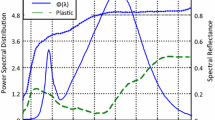Abstract
Performance of visible light communication systems which is encoded using turbo product codes is studied in this article. It is the first time to show the effect of turbo product codes in these systems. We chose ceiling bounce model since its accuracy with the practical measurements is proved. Our simulations are carried out in two different link distance and two different data rates. Encoder parameters are selected according to the code rate. This way, meaningful comparison can be made among the results considering distance, data rate, and code rate. Our investigations infer that using turbo product codes, higher data rate is achieved where link distance is the same. Similarly, it can be reached higher link distance when data rate is set to a constant value.












Similar content being viewed by others
References
Gazi, O. (2020). Forward error correction via channel coding (1st ed.). International Publishing.
Pyndiah, R. M. (1998). Near-optimum decoding of product codes: Block turbo codes. IEEE Transactions on Communications, 46(8), 1003–1010. https://doi.org/10.1109/26.705396
Li, J., Kurtas, E., Narayanan, K. R., & Georghiades, C. N. (2001). On the performance of turbo product codes over partial response channels. IEEE Transactions on Magnetics, 37(4), 1932–1934. https://doi.org/10.1109/20.951012
Sun, L. Y., Song, H. W., Keirn, Z., & Kumar, B. V. K. V. (2006). Field programmable gate array (FPGA) for iterative code evaluation. IEEE Transactions on Magnetics, 42(2), 226–231. https://doi.org/10.1109/Tmag.2005.861744
Argon, C., & McLaughlin, S. W. (2002). Optical OOK-CDMA and PPM-CDMA systems with turbo product codes. Journal of Lightwave Technology, 20(9), 1653–1663. https://doi.org/10.1109/Jlt.2002.802224
Mizuochi, T., Miyata, Y., Kobayashi, T., Ouchi, K., Kuno, K., Kubo, K., et al. (2004). Forward error correction based on block turbo code with 3-bit soft decision for 10-Gb/s optical communication systems. IEEE Journal of Selected Topics in Quantum Electronics, 10(2), 376–386. https://doi.org/10.1109/Jstqe.2004.827846
Mukhtar, H., Al-Dweik, A., Al-Mualla, M., & Shami, A. (2013). Adaptive hybrid ARQ system using turbo product codes with hard/soft decoding. IEEE Communications Letters, 17(11), 2132–2135. https://doi.org/10.1109/Lcomm.2013.092813.131480
Yang, S. H., Han, Y., Wu, X. B., Wood, R., & Galbraith, R. (2015). A soft decodable concatenated LDPC code. IEEE Transactions on Magnetics. https://doi.org/10.1109/Tmag.2015.2441055
Xu, C. L., Liang, Y. C., & Leon, W. S. (2007). Shortened turbo product codes: Encoding design and decoding algorithm. IEEE Transactions on Vehicular Technology, 56(6), 3495–3501. https://doi.org/10.1109/Tvt.2007.901931
Mukhtar, H., Al-Dweik, A., & Shami, A. (2016). Turbo product codes: Applications, challenges, and future directions. IEEE Communications Surveys & Tutorials, 18(4), 3052–3069. https://doi.org/10.1109/Comst.2016.2587863
IEEE. IEEE Standard for Local and metropolitan area networks--Part 15.7: Short-Range Optical Wireless Communications. 2019. p. 1–407.
Carruthers, J. B., & Kahn, J. M. (1997). Modeling of nondirected wireless infrared channels. IEEE Transactions on Communications, 45(10), 1260–1268. https://doi.org/10.1109/26.634690
Ghassemlooy, Z., Popoola, W., & Rajbhandari, S. (2017). Optical wireless communications: System and channel modelling with MATLAB®. CRC Press.
Huang, X., Chen, L., Chen, W. J., & Jiang, M. (2019). Design of multilevel reed-solomon codes and iterative decoding for visible light communication. IEEE Transactions on Communications, 67(7), 4550–4561. https://doi.org/10.1109/Tcomm.2019.2904563
Tang, C. J., Jiang, M., Shen, H., & Zhao, C. M. (2015). Analysis and optimization of P-LDPC coded RGB-LED-based VLC systems. IEEE Photonics Journal. https://doi.org/10.1109/Jphot.2015.2498541
Wang, H., & Kim, S. (2019). Design of polar codes for run-length limited codes in visible light communications. IEEE Photonics Technology Letters, 31(1), 27–30. https://doi.org/10.1109/Lpt.2018.2881223
Lee, S. H., & Kwon, J. K. (2012). Turbo code-based error correction scheme for dimmable visible light communication systems. IEEE Photonics Technology Letters, 24(17), 1463–1465. https://doi.org/10.1109/Lpt.2012.2199104
Author information
Authors and Affiliations
Corresponding author
Ethics declarations
Conflict of interest
We declare that there is no conflict of interest.
Additional information
Publisher's Note
Springer Nature remains neutral with regard to jurisdictional claims in published maps and institutional affiliations.
Rights and permissions
About this article
Cite this article
Bayraktar, M. Performance Analysis of Turbo Product Codes in Multipath Visible Light Communication Systems. Wireless Pers Commun 121, 3151–3161 (2021). https://doi.org/10.1007/s11277-021-08867-5
Accepted:
Published:
Issue Date:
DOI: https://doi.org/10.1007/s11277-021-08867-5




